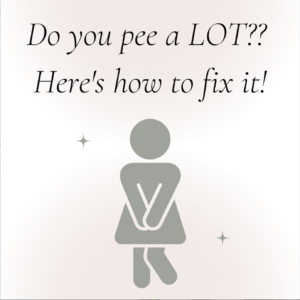Fixing urinary frequency and urgency
First, a little bladder science education:
- Normal urinating is 8-10 times during waking hours and 0-1 time during sleeping hours. If you are going to the bathroom more frequently than this, or leaking on your way to the bathroom, urge suppression techniques may help.
- When the bladder wants to empty, it talks to the brain in a wave-like pattern, with the first “wave” or urge more gentle than the next one. The first urge signal should be sent to the brain when the bladder is about 1/2 full. A full bladder can hold about 2 cups of fluid (or even up to 4 cups during sleeping!)
- When the bladder wants to empty, the muscle lining the bladder (the detrusor muscle) will start to contract/quiver slightly. When this urge is presents, it’s important that you are in charge of telling your bladder when it’s okay to empty, and not the other way around.>>>>>> The bladder is highly trainable! <<<<<<<<

When the bladder is allowed to control the urges and the timing of voiding, it will re-train itself to give more and more frequent urges. The bladder is easily excitable, and responds quickly to stress, up-regulating and ramping up urge signals in response to increased stress. It is important for urinary urgency and urinary incontinence to decrease both life stressors and your stress response when feeling an urge to go.
When possible, avoid going to the bathroom “Just in case” you think you will have to go soon. “Just in case-ing” will allow the bladder to empty more frequently, and it will begin to send urge signals when it is less and less full, resulting in more frequent urinary urgency. If an urge to urinate occurs and you need a bit more time to make it to the bathroom, try the urge suppression techniques listed below to avoid leaking.
Step by step guide to slow it down
1) Pause what you are currently doing! – Stop activity, stand quietly, or calmly sit down in a chair. Avoid rushing to the toilet. IF you are in a private place- pressing on your urethra can help.
2) Deep breath – Take a deep diaphragmatic (belly breath and let it out slowly. Then, contract your pelvic floor muscles on and off quickly by squeezing and LIFTING, then relax– 5 to 6 times. Pelvic floor contractions send a message to the bladder muscle to relax and hold urine. If you don’t have any urine loss with the quick contractions, progress to Contract, Relax slower and rhythmically 5 to 6 times to decrease the urgency.
3) Distraction techniques – Relax. Do not rush to the toilet. Try to distract yourself by thinking of something other than going to the bathroom. Look around you and distract your mind by reading any text you can see (billboard, a nutrition label, a text message, etc.)
4) Positive thinking — Think positive thoughts (“I am in control.” “I have enough time.” “My bladder is elastic and can expand to fill.” “I am in charge.” “I just went to the bathroom and know that my bladder is trying to control me.”)
5) Calmly walk to the bathroom. – When you feel the urge subside, walk normally to the bathroom (don’t rush!). Do not undo your belt, button, or pull down your pants on the way there. Urinate after you fully sit on the toilet and take a deep breath.
6) Ensure you fully void – It’s important that you fully relax while urinating. Do not try to push urine out (this can cause lots of other problems). After you think you are finished, try taking one more deep belly inhale and exhale just to make sure.
Do you feel another urge to go to the bathroom right after you just went?
If you feel the need to go to the bathroom right after you just went, you can try “double voiding:” After fully urinating, go ahead and stand up all the way. Then sit back on the toilet and repeat your belly breaths, relaxing to allow the flow of urine. You can also try gently rocking your chest forward, backward, and side to side to see if that helps urine flow. Another technique to try is bladder tapping: use your fingertips to tap gently on your bladder area a few times to help activate the bladder muscle to fully empty.
